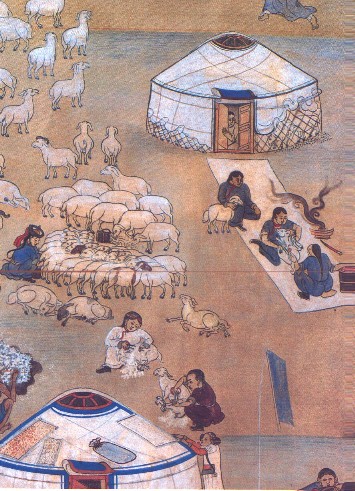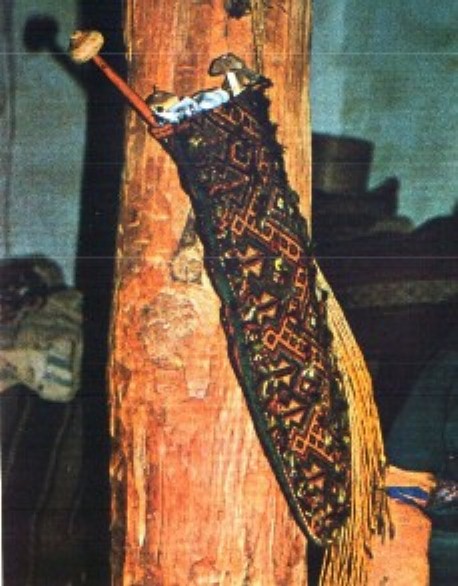| sprice@hsc.vcu.edu
Dear Kenneth, The fact that there are no published photos of particular
items being used in particular ways is not, in my mind, of great
importance. After all, I have hundreds of pictures of things I've taken in
my travels, but they don't find their way into print, and I'm sure the
same is true of pictures taken (or drawn) by pre-20th century travelers to
western and central Asia. As for the ensi, there is a sketch of a
Turkmen tent with a rug for a door that was included in a letter from Sir
Edward Durrand to his daughter in 1885, and I remember seeing a 19th
century drawing of a Turkmen tent with a door rug elevated on poles to
form a canopy, although I don't recall where. I don't see what a
kapunuk could be used for except a door surround, although it is
conceivable that it was used in conjunction with something else for some
other function. The spindle bag is a particularly interesting example. I
think the word for which you were searching is igselik, or
something similar to that. It is a bag about 18" x 9", open at the top
(one narrow end). The spoon bag, or chemche torba (chemche =
spoon; torba = bag) is, as nearly as I can tell, identical in every
way. I have never seen any justification for giving these different names,
although there are books showing what are purported to be each type on the
same page! My guess is that the situation is not unlike the two drawers at
the top of my bureau. One is my socks drawer, the other is my underwear
drawer. There is no difference between them except for the contents. But
if I was visited by an anthropologist and he pointed to the one on the
left and asked me what it was, I'd answer "socks drawer". If I was visited
by another antrhopologist and asked what the one on the right was, I'd
answer "underwear drawer". And perhaps this would lead to a debate some
day about exactly how to tell one from the other. I dealt with this matter
in a article in HALI awhile ago (No. 69, p. 77), and proposed that these
things just be called "portrait format bags". The rug world promptly
consigned this suggestion to the dust bin, where it lies quietly except
for occasions like this one. Steve Price |
 If Iím correct both, the bullock or yak
and the camel are each carrying the centrepiece of a yurt dome and bundles
of yurt poles. The poles carried by the bullock are rather loose but those
on the camel are well tied together and their ends seem to stick into
something similar to an ok-bash. The picture isnít as detailed to make me
really sure about my interpretation but it may points to a certain
direction until the publication of relevant photos. Regards,
Christoph
If Iím correct both, the bullock or yak
and the camel are each carrying the centrepiece of a yurt dome and bundles
of yurt poles. The poles carried by the bullock are rather loose but those
on the camel are well tied together and their ends seem to stick into
something similar to an ok-bash. The picture isnít as detailed to make me
really sure about my interpretation but it may points to a certain
direction until the publication of relevant photos. Regards,
Christoph
 One can not only see stiff felt
door coverings rolled up, but a bow and arrows in a quiver (definitely not
an ok bash) on one ger/yurt and rugs drying/air on top of another. Best
regards, Kenneth
One can not only see stiff felt
door coverings rolled up, but a bow and arrows in a quiver (definitely not
an ok bash) on one ger/yurt and rugs drying/air on top of another. Best
regards, Kenneth Here is the photo of the
Turkish spindle bag (holding spindles) that I mentioned in my earlier post
on this thread. The picture is from a book on kilims and flatweaves by
Belkis Acar and published in Turkey in 1975 by the Akbank. As you can see
it is perfectly suited to its function, though it could also hold any
spoon-like implement with a long handle. The text doesn't give it a name,
but mentions that the woman in the photo (suppressed to save space) is
using an ig, pronounced "eeee". Regards, Kenneth
Here is the photo of the
Turkish spindle bag (holding spindles) that I mentioned in my earlier post
on this thread. The picture is from a book on kilims and flatweaves by
Belkis Acar and published in Turkey in 1975 by the Akbank. As you can see
it is perfectly suited to its function, though it could also hold any
spoon-like implement with a long handle. The text doesn't give it a name,
but mentions that the woman in the photo (suppressed to save space) is
using an ig, pronounced "eeee". Regards, Kenneth